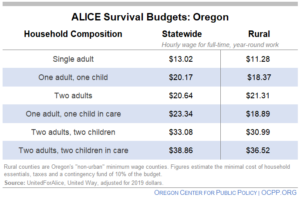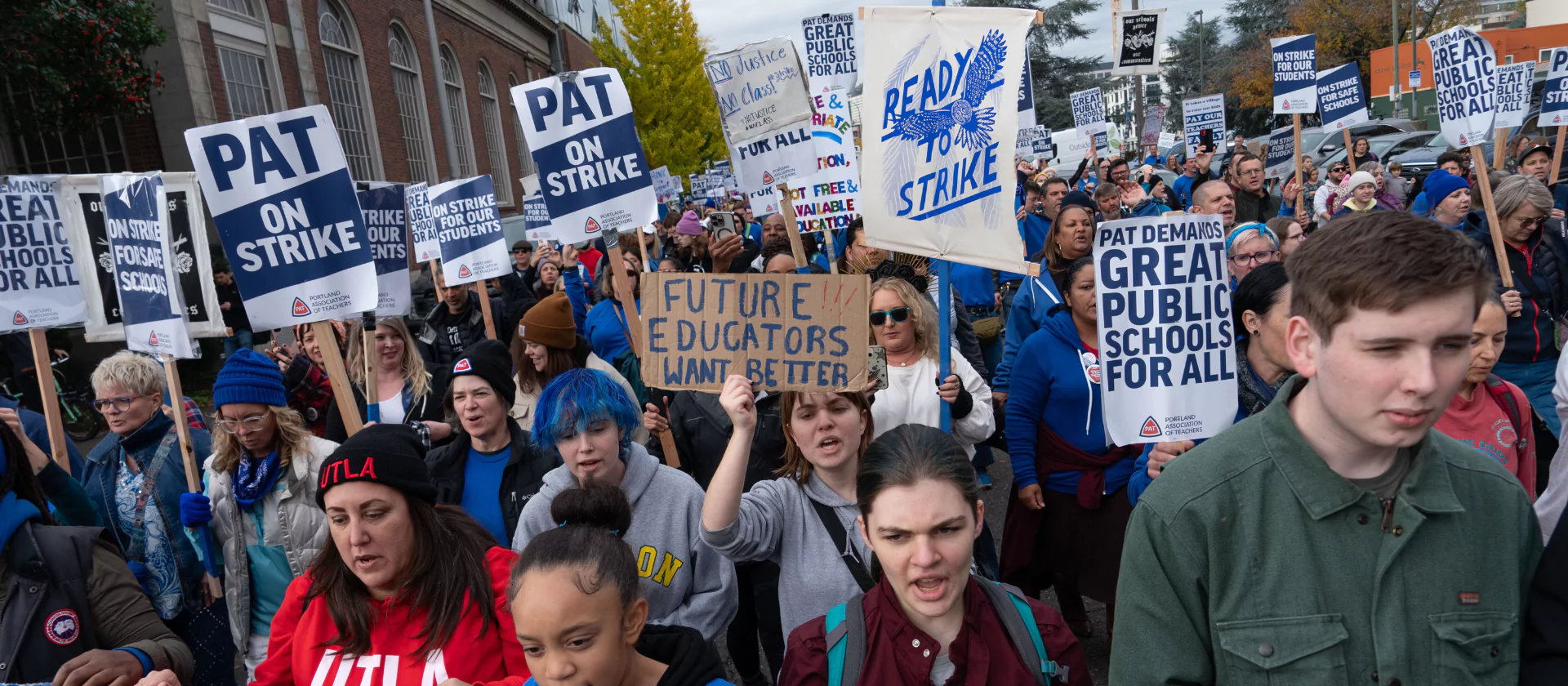Executive summary
On the eve of the pandemic, a time when the nation was experiencing the longest economic boom on record, poor quality jobs predominated in Oregon. In 2019, more than half of all jobs paid too little to adequately support a family. Many of these jobs not only paid poorly, they offered insufficient hours and few benefits like health insurance. Specifically:
- In 2019, a full-time, year-round job paying $20 per hour was insufficient for a two-person household to cover basic necessities. More than half of all Oregon jobs in 2019 paid under $20 per hour, below the “survival budget” level for most Oregon households.
- Though poor-quality jobs afflict all Oregon communities, rural counties, communities of color, and women disproportionately suffer from this structural problem.
- The leisure and hospitality industry and the retail industry are hot spots for low-wage jobs. Together they accounted for nearly half of the one million jobs in Oregon paying less than $15.00 in 2019.
- Though wages have been rising in recent months, the welcome development does not fundamentally change the fact that many jobs pay too little to cover the cost of basic needs. For one, inflation limits the impact of the wage increases. Ultimately, the gap between what many lower-wage jobs pay and what workers need to survive is far larger than the wage increases now being offered.
On top of low pay, poor quality jobs often come with additional challenges. These include the lack of benefits like health insurance, insufficient work hours, and unpredictable work schedules. These challenges more often affect workers who hold part-time jobs, a significant share of whom desire to work full time but cannot because their employer doesn’t offer more hours of work.
Some of the steps Oregon can take to improve the quality of jobs include:
- Improving workers’ ability to negotiate for better pay and working conditions. Oregon should ensure the right to organize for farmworkers and others, strengthen protections for nontraditional workers, support industry-wide wage and labor standards, increase enforcement funding and institute strategic enforcement models, and ensure public dollars go to support good jobs.
- Boosting worker income. Oregon should continue to increase the minimum wage, increase the state’s Earned Income Tax Credit (EITC), and invest in taxpayer assistance.
- Reducing the cost of basic needs. Oregon should institute universal, affordable child care; establish statewide, long-term rent assistance; make health insurance more affordable; and boost nutrition assistance.
Introduction
On the eve of the pandemic, a time when the nation was experiencing the longest economic boom on record, poor quality jobs predominated in Oregon. In 2019, more than half of all jobs paid too little to adequately support a family. Many of these jobs not only paid poorly, they offered less than full-time work and few benefits like health insurance. Though poor-quality jobs afflict all Oregon communities, rural counties and communities of color suffer disproportionately from this structural problem.
Oregon can improve the well-being of a large share of its people by taking steps to improve the quality of jobs. It can do so through policies that improve workers’ ability to negotiate for better pay and working conditions, boost the incomes of workers paid low wages, and make basic necessities more affordable.
More than half of jobs pay too little for most Oregonians to make ends meet
Right before the start of the pandemic, more than half of all jobs in Oregon paid too little to adequately support a family. That large share of poorly paid jobs existed at a time when the country had recorded the longest economic expansion on record, and at a time when the state boasted an annual unemployment rate of 3.7 percent, close to an all-time low.[1]
In 2019, a full-time, year-round job paying $20 per hour was insufficient for a two-person household to cover basic necessities. This conclusion is based on applying the Asset Limited, Income Constrained, Employed (ALICE) methodology developed by the United Way. Among other things, ALICE estimates the bare minimum families need make ends meet — the minimum needed to cover a “survival budget.”[2] To achieve that survival budget, Oregon households of more than one person — which describes three of every four working-age households — would have needed to make at least $20.17 an hour in 2019.[3]
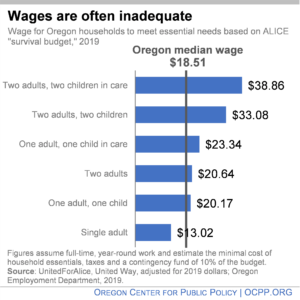
United Way researchers also estimated the wages needed to maintain a household in Oregon over time, termed a “stability budget.” The stability budget for various household compositions is shown in Appendix A.
More than half of all Oregon jobs in 2019 paid under $20 per hour, below the “survival budget” level for most Oregon households. More than 1 million jobs in Oregon paid less than $15 per hour in 2019. That amounted to one-third (33 percent) of all jobs in the state that year. Another 700,000 jobs, or 22 percent of jobs, paid between $15 and $20 per hour, still less than what most Oregon households require to meet their basic needs, even when working full-time.
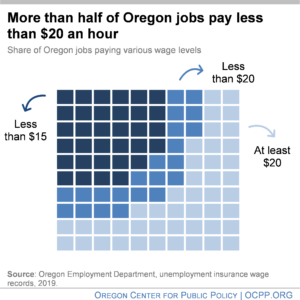
Some communities of color are more likely to labor in low-paying jobs compared to other groups. This is driven by past and present government policies limiting the educational and economic opportunities that enable people to access lucrative jobs, as well as by workplace discrimination.[4]
In 2018, the year with the most recent data available, the average wages of Black and brown workers in Oregon were a fraction of those of non-Hispanic white workers.[5] Specifically, Black workers were paid 81 percent of what non-Hispanic white workers were paid, and both Indigenous and Latino workers were paid 69 percent of that level. Asian workers — a diverse group — were paid average wages 119 percent of what non-Hispanic white workers were being paid, although that figure masks considerable variation in wages within the group.
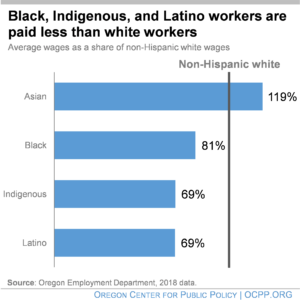
Women, too, were more likely to work in low-paying jobs. The long-standing gender wage gap in Oregon persisted in 2019. That year, Oregon women were paid 82 cents on the dollar of what men were paid.[6]
Although poor-quality jobs could be found across the state, jobs in rural Oregon were more likely to pay too little to meet basic needs, compared to jobs in urban areas. It is the case that the cost of living tends to be lower in rural areas. In 2019, the household survival budgets for rural Oregon counties were 6 to 13 percent lower than the survival budget for the state as a whole, depending upon household composition.[7] At the same time, wages in rural areas tend to be considerably lower than those for the state generally. For example, in 2019, wages in rural areas of Lane county were 29 percent lower than wages overall in Oregon.[8]
Appendix B compares the overall Oregon survival budget and an average survival budget for Oregon’s rural counties in 2019.
The Federal Poverty Guidelines are a poor measure of poverty
The Federal Poverty Guidelines, the traditional measure of the resources needed to support a household’s basic needs, have little connection to what families actually need to make ends meet. Each year, the U.S. Department of Health and Human Services adjusts the Federal Poverty Guidelines to inflation. Although they may have accurately reflected the cost of basic needs when they were established in the early 1960s, there is wide recognition that the method employed by the Federal Guidelines for measuring poverty is outdated.[9] Depending on household composition, the Federal Poverty Guidelines are half or more below what a household requires to pay for the essentials.
Many vital jobs pay too little
Many jobs important to the well-being of Oregonians and the functioning of the state pay little. The leisure and hospitality industry and the retail industry are hot spots for low-wage jobs. In 2019, these industries had median wages of $13.78 and $13.99, respectively. Nearly half of the one million jobs in Oregon paying less than $15.00 were in one of those two industries. Natural resources, which includes Oregon’s essential agricultural workers, had median wages of $15.00 an hour — below a “survival” budget for most families. By contrast, the highest-paid jobs were in the construction and information industries, where the median wage in 2019 was $25.52 and $32.39 respectively.[10]
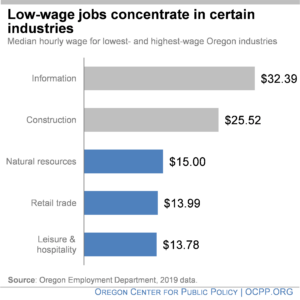
A closer look at detailed occupational categories sheds more light on the realities of compensation for frontline and non-supervisory workers in these industries. Within the leisure and hospitality industry, the median wage (including tips) for servers in Oregon in 2019 was $12.22 an hour; for housekeeping cleaners the figure was $13.01. In retail, non-supervisory salespersons were paid a median wage of $13.39. And farmworkers were paid $12.86 per hour.[11] Although these median wage levels may have been at or above Oregon’s minimum wage at the time, it’s hard to imagine they afforded workers the opportunity to live free of economic hardship or invest in their own and their family’s future.
Recent wage increases don’t change the game
Though wages have been rising in recent months, this welcome development does not fundamentally change the fact that many jobs pay too little to cover the cost of basic needs.
For one, inflation limits the impact of the wage increases. Recent wage increases in the leisure and hospitality industry have garnered attention. Oregon Employment Department data shows average wages in this industry increased $1.60 an hour since the start of the pandemic — an increase of 9 percent over 17 months.[12] After accounting for inflation though, average wages in the industry increased just 3.6 percent over the period. The recent increases may seem more substantial, in part, because they are making up for months of fallen wages in the industry over the previous year.[13]
Ultimately, the gap between what many lower-wage jobs pay and what workers need to survive is far larger than the wage increases now being offered. For instance, a single cashier working full time making $11.59 per hour — a wage greater than one in four Oregon cashiers were getting pre-pandemic — would need a 12 percent boost just to meet their basic needs. To also support a school-age child, that cashier would need a 74 percent wage boost.[14]
Jobs often fail to provide enough hours
The financial challenges for Oregonians working for low wages become even more difficult when their job doesn’t offer full time work. One in four workers in Oregon worked part time in 2019.[15] That share is slightly higher than the national figure.[16]
While some part-time workers prefer the limited schedule, others would work full time if they could. In the strong economy of 2019, more than one in eight part-time workers nationally would have worked full time but for the fact that they weren’t being offered more hours by their boss.[17] In sum, at a time when the job market was stacked in their favor, some part-time workers wishing to work more could not get more hours of work.
Involuntary part-time work is a race and gender issue. Nationally in 2019, Black and Latino workers were more likely than white male workers to be working part time involuntarily. The largest disparity was for Latina women, who were nearly twice as likely as white male workers to be working part time despite their preference for full-time work, because the job offered too few hours.[18]
Low-wage jobs are more likely to fall below 35 hour per week — the threshold of what is considered full time.[19] National data on hours in various industries and occupations sheds light on this situation. Food service workers have some of the lowest levels of weekly hours of any occupational group, averaging just 25 hours per week. Personal care assistants and child care workers clock an average of 29 hours per week, while retail sales personnel and cashiers fare only slightly better at 30 hours per week.[20] The pattern of hours associated with these occupations has persisted for decades.[21]
Full-time work is a privilege of the better-paid. Machinists and welders, for example, have average wages above $20 an hour and work over 40 hours per week, on average. Similarly, insurance agents and claims adjusters are paid above $25 an hour and work 38 hours per week, on average.
Part-time work and low pay go hand-in-hand
Researchers have noted the existence of a “part-time wage penalty.” Specifically, they have found that part-time workers get paid about 20 percent per hour less than full-time workers, despite having similar demographic characteristics and education levels.[22] The findings account for the fact that lower-wage industries tend to have more part-time jobs. Bottom line: part-time workers are paid less simply because they work part time.
Many low-wage and part-time workers lack health insurance
Having health insurance helps workers stay healthy and employed. Health insurance also protects workers’ finances from debilitating medical bills. Unfortunately, not all Oregon workers enjoy health coverage. This is especially true for people working for low wages, working part time, or working in non-unionized settings.
One in 10 Oregon workers lacked health insurance in 2019, at a time when the state enjoyed one of the strongest job markets in decades.[23] Most workers with health insurance — seven in 10 — obtained coverage through their job. Other workers with insurance purchased it on their own or were covered by public insurance such as the Oregon Health Plan and Medicare.[24]
Employers in some industries in Oregon are more likely to offer health insurance than others. In 2018, the relatively higher-wage wholesale trade and manufacturing industries frequently offered medical insurance to full-time employees (74 percent and 69 percent of industry employers, respectively).[25] At the same time, the lower-wage retail trade and leisure and hospitality industries were less likely to offer such insurance to full-time workers (50 percent and 33 percent of industry employers, respectively).
It was rare for part-time employees to have job-based health insurance, regardless of industry. In no industry did more than a quarter of businesses offer health insurance to part-time employees.[26]
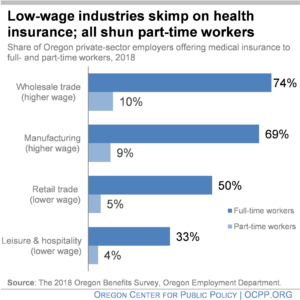
Given the failure of employers to offer health insurance to part-time workers, it comes as no surprise that part-time workers are more likely to be uninsured than full-time workers. One in seven part-time workers (13 percent) in Oregon had no health insurance in 2019, while one in 12 full-time workers (9 percent) were uninsured.
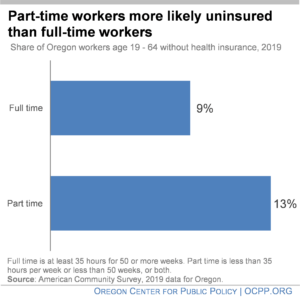
Working in the public sector greatly increases the odds workers have health insurance coverage. Nationally in 2019, just 24 percent of private-sector employees in the lowest wage group (the lowest 10 percent) were offered health benefits, and only 14 percent signed up for the coverage, likely due to the cost.[27] And just 23 percent of part-time workers in the private sector were similarly offered benefits.[28] But among low-wage workers employed by state and local governments, more than 60 percent were offered health benefits and 52 percent were able to participate.
Even more determinant of health coverage is whether the worker belongs to a union. In 2019, nearly all (94 percent) of private-sector union workers were offered health insurance, compared to 67 percent of non-unionized private sector workers. This union advantage also exists among public sector workers. In 2019, 95 percent of public sector workers belonging to a union were offered health insurance, compared to 84 percent of non-union public employees.[29]
Oregon employees have sick leave, but not everyone gets paid leave
Thanks to a law enacted in 2015, nearly all Oregon workers can take time off when they get sick.[30] Several years into the law, it is unclear how many workers are compensated when they use their sick leave. It is clear, however, that some don’t get paid.
Oregon’s paid sick leave law has helped relieve workers of the fear of losing their job when they get sick. While not all workers get paid when they take time off, under the law they cannot be fired for using accrued sick leave. Temporary, part-time, and piece-rate employees are included. Workers at companies of 10 or more employees (six or more for businesses in Portland) must be paid when they take sick leave. Prior to the law, many temporary and part-time workers risked losing their job if they called in sick.
It is difficult to determine how many Oregon employees have no paid sick leave, due to the lack of current state-level, employee-specific data on benefits. Many likely do not, since there are many firms in Oregon of fewer than 10 employees. In 2018, only 47 percent of Oregon employers reported offering paid sick leave to full-time employees and just 32 percent of them reported offering paid sick leave to part-time employees.[32] Expenses for food, rent, and other essentials, of course, do not pause when an employee falls ill.
Universal paid sick leave was federal law for a brief period
In the interest of public health, Congress required that all workers have paid sick leave during the initial months of the COVID-19 pandemic. The Families First Coronavirus Response Act, enacted in March 2020, provided resources for paid sick leave until the end of 2020.[33] That paid sick leave requirement has now expired. The public health imperative for paid sick leave, however, exists even in times when there is no pandemic.
Unpredictable work schedules continue to take a financial and emotional toll
Oregon took an important step in helping workers gain more predictable work schedules, but challenges remain.
By 2016, consistent with national trends, Oregon employers frequently used “just-in-time” staffing strategies in an effort to curb labor costs. Using scheduling algorithms, some employers offered little advance notice of a work schedule or a schedule change, and gave preference to employees who were able to respond on short notice. A survey of lower-wage workers in 2016 found that a quarter of them were being scheduled for on-call shifts. Nearly three quarters were expected to have open availability to get more hours or a better schedule. Over 40 percent reported being sent home early, and more than a third had less than a week’s notice of their schedule.[34] The survey sample found irregular and unpredictable scheduling more frequently in hospitality, food service, and retail industries.
National studies have found that the lowest-income workers have the most irregular work schedules. Part-time workers were twice as likely to have variable hours than full-time workers.[35] Unpredictable work schedules were found to be more common among non-white workers, women, private-sector workers, and non-unionized employees.[36]
Unpredictable work schedules can wreak havoc on worker finances and family life.[37] One of the effects of just-in-time staffing is to reduce the earnings of workers. And because workers are penalized for being unavailable for short-notice requests, they often are unable to supplement reduced earnings with a second job. Unpredictable scheduling makes it difficult for workers to plan for child care or attend to other responsibilities at home.
In response to growing hardship, the Oregon legislature enacted a bill in 2017 to regulate scheduling practices among large retail, food service, and hospitality establishments.[38] A survey of workers conducted several years later in 2019 found some improvement in their circumstances.[39] Workers were having at least 10-hour breaks between shifts, as required. Workers were being allowed input into their work schedules without retaliation and were provided work schedules at least a week in advance. (The law required two-weeks’ notice starting in 2020.)
At the same time, other challenges continued. The law required employers to provide extra pay in the case of last-minute scheduling changes, but the law also provided exceptions to that rule. Employers were found to be claiming those exceptions routinely, continuing to make last-minute scheduling changes with no extra compensation. Employers also appeared to be abusing a provision to create a “stand-by list,” where workers can indicate willingness to work on short notice and are not compensated for their stand-by status nor for last-minute scheduling changes. And workers reported continued difficulty in getting enough hours.[40]
Oregon should act to improve job quality
Oregon can and should take steps to improve the quality of jobs, for the sake of workers and the economy. Poor quality jobs undermine the ability of workers to sustain employment and raise their children. Such jobs also limit local economic growth by depriving employers of a stable, healthy workforce and customers with resources to purchase goods and services.[41]
The following is an outline of some of the steps Oregon can take to improve the quality of jobs. It is not meant to be an exhaustive list of all of the policy solutions that would improve the quality of jobs.
Improve workers’ ability to negotiate for better pay and working conditions
When workers join with other workers, they are better able to bargain for improved pay and benefits. The presence of unions in an industry raises wages and job standards for everyone, unionized or not.[42] But businesses routinely intimidate workers to quash organizing efforts.[43] Oregon can strengthen the voice of workers and address their challenges in several ways:
- Ensure the right to organize for farmworkers and others. Farmworkers are excluded from the federal National Labor Relations Act that protects a worker’s right to collective bargaining and Oregon has not granted that right to the many workers who drive the state’s agricultural sector.[44] Meanwhile, independent contractors are not considered employees and, as such, lack many of the workplace protections that apply to employees. They are vulnerable to labor abuses and can struggle to find recourse. To ensure all workers in Oregon have a voice in the terms and conditions of their work, Oregon should clarify and extend the right to organize to farmworkers and independent contractors.
- Strengthen protections for nontraditional workers. Gig, temporary, online-platform, on-call, and part-time workers are often wrongly classified as independent contractors. As such, they do not have many of the legal protections and benefits other workers enjoy, including collective bargaining. Oregon should step up efforts to prevent misclassification. Oregon should also create “portable benefit” structures that allow nontraditional workers to accrue and use benefits, such as paid time off, contributed by multiple employers.[45]
- Support industry-wide wage and labor standards. Oregon can establish wage boards of stakeholders to recommend wage levels and benefits for entire industries or occupation groups. Such boards can promote the interests of workers in non-unionized industries or where outsourcing makes it hard for workers to bargain at a worksite. Evidence shows that industry or occupation-level standards can encourage businesses to compete based on productivity, rather than low wages, and help close racial and gender pay gaps.[46]
- Increase enforcement funding and institute strategic enforcement models. While on paper wage, workplace, and safety laws protect workers, these laws often aren’t enforced, leaving workers at the mercy of unscrupulous employers. Oregon should increase the capacity of state agencies to enforce workplace laws. The state should partner with worker organizations to expand on-the-ground capacity, reach a wide range of workers, educate workers on their rights, and assist workers wanting to rectify issues in their workplaces.[47]
- Ensure public dollars support good jobsOregon contracts with many private firms for goods and services, ranging from the construction and maintenance of infrastructure to housing development to the provision of social services. These contracts offer opportunities for raising labor standards in the private sector. Oregon should expand its efforts to ensure that public dollars support good jobs by requiring compliance with a set of labor standards in its contracts.
Boost worker income
Oregon should address the problem that wages for many workers are inadequate for meeting basic needs, through the following strategies.
- Continue to increase the minimum wage. Since 2016, Oregon has been gradually increasing the state’s minimum wage. When the last scheduled annual increase takes place in 2022, the minimum wage will have reached $14.75 in Portland, $12.75 in other urban areas, and $12.00 in non-urban counties. These increases have protected hundreds of thousands of workers from worse financial hardship and have pumped dollars into local economies.[48] Oregon should continue raising the wage floor, with the goal of $20 an hour for most areas of the state.
- Increase the state’s Earned Income Tax Credit (EITC). The EITC is an effective and efficient way to improve the bottom line for households and improve the current and future well-being of children.[4] Oregon has one of the lowest state EITCs, providing an average of $260 for families with children. Other states have done a better job of harnessing the benefits of the EITC by providing a credit two to three times greater than what Oregon provides. Oregon should join them.
- Invest in taxpayer assistance. Investing in taxpayer assistance would help workers receive the benefit of federal and state tax credits that supplement meager wages and support the well-being of children. Oregon’s system of free taxpayer assistance is vastly under-resourced, serving just one in seven households seeking assistance in filing their taxes.[50] Additional investments in taxpayer assistance would enable more tax credit dollars to flow to households with modest incomes who confront barriers to filing taxes.
Reduce or offset the cost to households of basic needs
Lowering the cost of basic needs is another way to help families make ends meet. Oregon could implement this approach in the following ways.
- Institute universal, affordable child care. The cost of child care is one of the biggest burdens for households raising children, and the existing subsidies are vastly insufficient to meet the need. Oregon should invest enough in child care so that all families have high quality care they can afford and is flexible enough to support parents’ work.
- Institute statewide, long-term rent assistance. Half of all Oregon renter households are officially “cost burdened” and nearly one in four renter households spend over half of their income on housing.[51] A long-term rent assistance program would help many of these cost burdened renters attain safe, stable, and affordable housing.
- Make health insurance more affordable. Oregon should increase subsidies for premiums in Oregon’s Health Insurance Marketplace and include a public option, which would likely put downward pressure on premiums.
- Boost nutrition assistance. Oregon should use state dollars to increase the benefits amounts that families receive under the federal Supplemental Nutrition Assistance Program (SNAP). The state should also devote resources to enable households without children to continue receiving benefits as long as they are income-eligible.
Congress should also respond to inadequacy of jobs
Congress can play an important role in ameliorating the shortcomings of today’s jobs. Congress is now considering legislation that would reduce the hardship experienced by workers in poor-quality jobs. The American Families Plan would make major investments in, among other things, child tax credits, rental assistance, child nutrition, and child care and preschool.[52] Congress should seize this opportunity to improve the lives of all Americans.
Conclusion
Even in the strongest of job markets, poor quality jobs have permeated the Oregon landscape. Poor quality jobs come with low pay, insufficient work hours, and few benefits like health insurance. The prevalence of low-quality jobs is a fundamental reason why so many Oregonians struggle to cover basic needs.
Oregon can take decisive steps to improve job quality, through policies that improve workers’ ability to negotiate for better pay and working conditions, boost worker incomes, and make basic needs more affordable
Appendix A
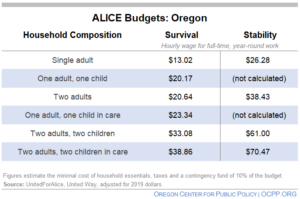
Appendix B
[1] Bureau of Labor Statistics, Local Area Unemployment Statistics.
[2] United For ALICE, United Way.
[3] The figures for households with children assume school-age children and after-school child care costs. Households with younger children have higher child care costs and require a higher survival budget wage. “Research Center: Oregon”, UnitedforAlice.org. Data, definition of terms, and methodology available .
[4]William Sites, Virginia Parks, What Do We Really Know about Racial Inequality? Labor Markets, Politics, and the Historical Basis of Black Economic Fortunes Sage Journals, March 3, 2011.
[5] The data source for wages by race are average wages and, therefore, not strictly comparable to median wage figures shown elsewhere in this report. The average hourly wage for Blacks in 2018 was $21.83, for Indigenous workers was $18.73, for Latinos was $18.66, for Asians was $32.19, and for non-Hispanic whites was $27.01. Oregon Employment Department analysis of U.S. Census Bureau Longitudinal Employer-Household Dynamics (LEHD) data, sent to OCPP by email by Sarah Cunningham August 16, 2021.
[6] The recent wage gap highs and lows for Oregon: In 2009, women were paid 76.8 percent what men were paid; in 2014, women were paid 82.5 percent. Women’s Earnings in Oregon — 2019, Bureau of Labor Statistics, news release.
[7] OCPP analysis of UnitedforAlice.org data, adjusted for 2019.
[8] For the rural wage gap, what’s missing matters, Oregon Employment Department blog, December 9, 2020.
[9] “Measuring Poverty,” The Self-Sufficiency Standard, University of Washington; also, The Official U.S. Poverty Measure is Based on a Hopelessly Out-of-date Metric, Washington Post, September 16, 2019.
[10] OCPP analysis of Quarterly Wage File Reports, Oregon Employment Department.
[11] Bureau of Labor and Industries, Occupational Employment Statistics (OES) Survey, May 2019 OES Estimates.
[12]OCPP analysis of Current Employment Statistics Survey data from Oregon Employment Department, provided by David Cook by email to the author on August 17, 2021.
[13] Ibid. Average nominal wages in Leisure and Hospitality in February 2020 were at $17.89 per hour. They dipped below $17.80 in June through September 2020.
[14] One in four cashiers in Oregon were paid $11.58 an hour or less in 2019. OCPP analysis of Occupational Employment Statistics (OES) Survey, May 2019 OES Estimates for Oregon, Bureau of Labor Statistics.
[15] Part-time is defined as work less than 35 hour per week. The definition takes into account hours worked in multiple jobs and includes seasonal jobs (those less than year-round) of less than 35 hour per week. OCPP analysis of American Community Survey data.
[16] Twenty-two percent of workers in the United States worked part-time in 2019. OCPP analysis of American Community Survey data.
[17] OCPP analysis of Bureau of Labor Statistics data.
[18] OCPP analysis of Bureau of Labor Statistics data: Labor Force Statistics from the Current Population Survey, Table 22.
[19] The American Community Survey considers full-time work to be at least 35 hours per week. See How are full-time/part-time and full year/part year workers defined in Census 2000 and the American Community Survey?.
[20] Bureau of Labor Statistics, “Employment, Hours, and Earnings from the Current Employment Statistics Survey”.
[21] Ibid.
[22] Part-time workers pay a big-time penalty Economic Policy Institute, February 27, 2020.
[23] American Community Survey data for 2019.
[24] Ibid.
[25] Average median wage in the wholesale trade industry was $23.44 per hour in 2019. It was $22.06 for manufacturing that year. “Oregonians @ Work Annual Wage File Table – 2019,” Oregon Employment Department. Also, Employer-Provided Benefit: Offerings, Enrollment, and Rising Costs, Oregon Employment Department, January 2019.
[26] Ibid.
[27] Average monthly health insurance premium for workers with average wages in the lowest 10 percent was $148.43 in 2019, the highest of any other wage group. National Compensation Survey: Employee Benefits in the United States, Table 11. Medical care benefits, single coverage: Employer and employee premiums by employee contribution requirement, private industry workers, March 2019.
[28] National Compensation Survey: Employee Benefits in the United States, “Table 9. Healthcare benefits: Access, participation, and take-up rates, private industry workers,” March 2019, Bureau of Labor Statistics.
[29] Seventy-three percent of non-unionized public-sector workers signed up for employer-sponsored health insurance in 2019. Ibid., “Table 9. Healthcare benefits: Access, participation, and take-up rates, state and local government workers, March 2019.
[30] Students in Federal Work Study programs and independent contractors are not covered by SB 454. See Sick Time, Frequently Asked Questions for Workers, Oregon Bureau of Labor and Industries; and University Human Resources – Benefits, Oregon State University.
[31] Ibid.
[32] Employer-Provided Benefits: Offerings, Enrollment, and Rising Costs, Oregon Employment Department, January 2019.
[33] Families First Coronavirus Response Act: Questions and Answers, U.S. Department of Labor.
[34] The Impact on Oregonians of the Rise of Irregular Scheduling, University of Oregon Department of Sociology, University of Oregon Labor Education and Research Center, and Portland State University, January 2017.
[35] Irregular Work Scheduling and Its Consequences, Economic Policy Institute, April 9, 2015, available at.
[36] “An individual had a reduced probability of not being able to specify their workweek if he fit in one or more of the following categories: a union member, a government employee (all levels, but particularly local public sector), has higher education, is white, is male, and is married.” Ibid.
[37] Ibid.
[38] SB 838 (2017).
[39] Persistent Unpredictability: Assessing the Impacts of Oregon’s Employee Work Schedules Law, University of Oregon Sociology Department, University of Oregon Labor Education and Research Center, and UFCW, January 2021.
[40]Ibid.
[41]Small Businesses Get a Boost from A $15 Minimum Wage, Center for American Progress, February 25, 2021; and Likely Effects of a $15 Federal Minimum Wage by 2024, UC Berkeley Center on Wage and Employment Dynamics, 2019.
[42]How today’s unions help working people, Economic Policy Institute, August 24, 2017.
[43]Fear at work: An inside account of how employers threaten intimidate, and harass workers to stop them from exercising their right to collective bargaining, Economic Policy Institute, July 23, 2020.
[44]Farmworker Labor, Legislative Committee Services, Background Brief, September 2012.
[45]Legislation considered in Washington State provides an example of a portable benefit structure for nontraditional workers. Washington Senate Bill 5690, 66th Legislature, Regular Session, January 28, 2019.
[46]What is Sectoral Bargaining?, Center for American Progress Action Fund, March 2, 2020.
[47]Strategic Enforcement and Co-enforcement of U.S. Labor Standards are Needed to Protect Workers Through the Coronavirus Recession, Washington Center for Equitable Growth, January 14, 2021.
[48] One in 10 Oregon jobs to pay more, following minimum wage hike, Oregon Center for Public Policy, July 1, 2021.
[49] EITC and Child Tax Credit Promote Work, Reduce Poverty, and Support Children’s Development, Research Finds, Center on Budget and Policy Priorities, October 1, 2015.
[50] Summary of Recommendations and Findings, Governor’s Earned Income Tax Credit Increasing Participation Work Group, May 11, 2020.
[51] One in Three Oregon Families Struggle to Afford Housing, Oregon Center for Public Policy, March 15, 2018.
[52] Recovery Proposals Adopt Proven Approaches to Reducing Poverty, Increasing Social Mobility, Center on Budget and Policy Priorities, August 5, 2021.

